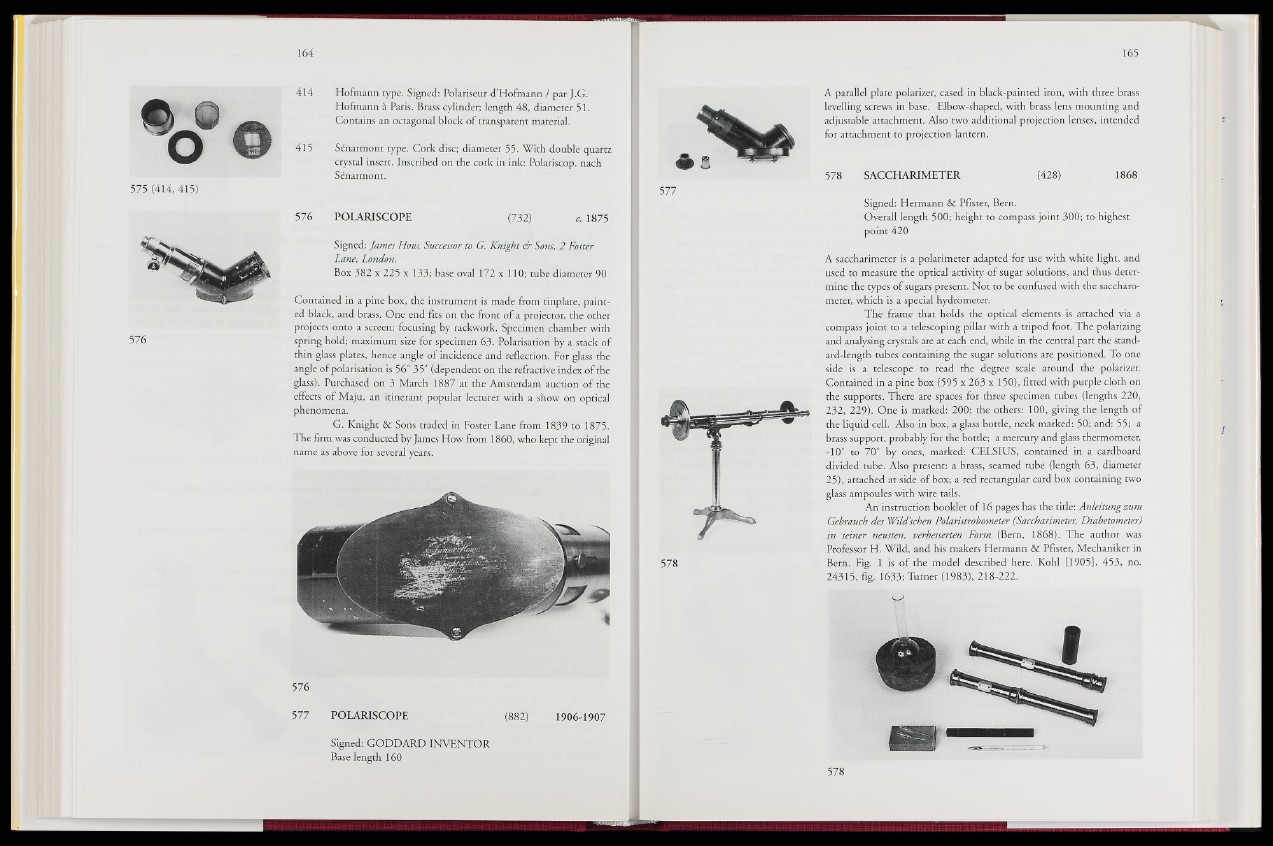
414 Hofmann type. Signed: Polariseur d’Hofmann / par J.G.
Hofmann k Paris. Brass cylinder; length 48, diameter 51.
Contains an octagonal block of transparent material.
415 S&iarmont type. Cork disc; diameter 55. With double quartz
crystal insert. Inscribed on the cork in ink: Polariscop. nach
Senarmont.
575 (414, 415)
576 POLARISCOPE 1 732) 1 1875
576
Signed: James How, Successor to G. Knight & Sons, 2 Foster
Lane, London.
Box 382 x 225 x 133; base oval 172 x 110; tube diameter 90
Contained in a pine box, the instrument is made from tinplate, painted
black, and brass. One end fits on the front of a projector, the other
projects onto a screen; focusing by rackwork. Specimen chamber with
spring hold; maximum size for specimen 63. Polarisaticin by a stack of
thin glass plates, hence angle of incidence and reflectiorb-For glass the
angle of polarisation is 56° 357 (dependent on the refractive index of the
glass). Purchased on 3 March 1887 at the Amsterdam auction of the
effects of Maju, an itinerant popular lecturer with a show on optical
phenomena.
G. Knight & Sons traded in Foster Lane from 1839 to 1875.
The firm was conducted by James How from 1860, who kept the original
name as above for several years.
576
577 POLARISCOPE (882) 1906-1907
Signed: GODDARD INVENTOR
Base length 160
A parallel plate polarizer, cased in black-painted iron, with three brass
levelling screws in base. Elbow-shaped, with brass lens mounting and
adjustable attachment. Also two additional projection lenses, intended
for attachment to projection lantern.
578 SACCHARIMETER (428) 1868
Signed: Hermann & Pfister, Bern.
Overall length 500; height to compass joint 300; to highest
point 420
A Saccharimeter is a polarimeter adapted for use with white light, and
used to measure the optical activity of sugar solutions, and thus determine
the types of sugars present. Not to be confused with the Saccharometer,
which is a special hydrometer.
The frame that holds B e optical elements is attached via a
compass joint to a telescoping pillar with a tripod foot. The polarizing
and analysing crystals are at each end, while in the central part the stand-
ard-length tubes containing the sugar solutions are positioned. To one
side is a telescope to read the degree scale around the polarizer.
Contained in a pine box (595 x 263 x 150), fitted with purple cloth on
the supports. There are spaces for three specimen tubes (lengths 220,
232, 229). One is marked: 200; the others: 100, giving the length of
the liquid cell. Also in box, a glass botde, neck marked: 50; and: 55; a
llffts Support, probably for the bottle; a mercury and glass thermometer,
-10° to 70° by ones, marked: CELSIUS, contained in a cardboard
divided tube. Also priflnt: a brass, seamed tube (length 63, diameter
25), attached at side of box; a red rectangular card box containing two
glass ampoules with wire tails.
An instruction booklet of 16 pages has the title: Anleitung zum
Gebrauch des Wild’schen Polaristrobometer (Saccharimeter, Diabetometer)
in seiner neusten, verbesserten Form (Bern, 1868). The author was
Professor H. Wild, and his makers Hermann & Pfister, Mechaniker in
Bern. Fig. 1 is of the model described here. Kohl [1905], 453, no.
24315, fig. 1633; Turner ( 1 9 |§ | 218-222.